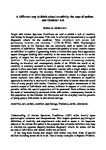A different way to think about creativity: the case of autism and Outsider Art
| dc.contributor.author | mckenzie or stancer, rebecca | |
| dc.date.accessioned | 2018-08-13T10:05:41Z | |
| dc.date.available | 2018-08-13T10:05:41Z | |
| dc.date.issued | 2011 | |
| dc.identifier.uri | http://hdl.handle.net/10026.1/12018 | |
| dc.description.abstract |
People with Autism Spectrum Conditions are said to exhibit a lack of creativity and fantasy in thought processes. This view is reflected in internationally accepted diagnostic criteria for the condition: ‘Most individuals with autism lack spontaneity, initiative, and creativity…’ (ICD-10 WHO; 1992). Psychological measures such as the Torrance test are commonly used to assess the artistic creativity of individuals. These tests measure the quantity of novel creative outputs an individual is capable of generating within a limited time span. Such approaches equate divergent thinking with creativity in the sense that the focus is not on the quality of output, but the rapid generation of numerous solutions to a creative ‘problem.’ This chapter questions psychological methods of assessing creativity, drawing on historical and contemporary works of art. Within the world of art, creativity is routinely assessed in terms of quality rather than quantity. Artistic genius is often associated with the obsessive concern with a single subject or the use of repetitive imagery. For example, Warhol, Cézanne and Picasso created numerous works of art which demonstrate an obsessive interest in a single subject matter explored from subtly different perspectives. An obsessive or repetitive approach to creativity is very much in keeping with what is known about the world view of many people with autism. Contrary to psychological assessments of the creative output of individuals with autism, evidence in support of a rich creative potential within this special population will be presented. Such evidence includes the work of internationally renowned artists with autism, contemporary interest in this population by the Outsider Art Movement and the everyday creative pursuits of young people with autism in educational settings. | |
| dc.format.extent | 107-119 | |
| dc.language.iso | en | |
| dc.publisher | inter-disciplinary.net | |
| dc.title | A different way to think about creativity: the case of autism and Outsider Art | |
| dc.type | journal-article | |
| dc.type | Article | |
| plymouth.publication-status | Published | |
| dc.identifier.doi | 10.1163/9781848881273_012 | |
| plymouth.organisational-group | /Plymouth | |
| plymouth.organisational-group | /Plymouth/Faculty of Arts, Humanities and Business | |
| plymouth.organisational-group | /Plymouth/REF 2021 Researchers by UoA | |
| plymouth.organisational-group | /Plymouth/REF 2021 Researchers by UoA/UoA23 Education | |
| plymouth.organisational-group | /Plymouth/Users by role | |
| plymouth.organisational-group | /Plymouth/Users by role/Academics | |
| dc.rights.embargoperiod | Not known | |
| rioxxterms.versionofrecord | 10.1163/9781848881273_012 | |
| rioxxterms.licenseref.uri | http://www.rioxx.net/licenses/all-rights-reserved | |
| rioxxterms.type | Journal Article/Review |


